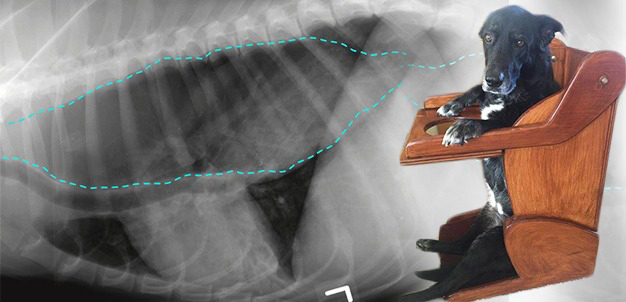Table of Contents
Is your dog unable to swallow properly and vomiting undigested food? He may suffer from megaesophagus.
Megaesophagus is a debilitating and serious disorder and if not kept under control can degenerate and lead to the dog’s death.

The esophagus connects the larynx with the stomach, transferring food through muscle movements.
When affected by this condition, the esophagus tends to dilate and its muscles undergo total or partial paralysis that make swallowing and assimilation of food difficult.
Unfortunately, drug therapy does not restore function to the esophagus, but it can relieve its symptoms by preventing it from degenerating and helping the dog live a dignified and as normal a life as possible.
In contrast, however, in felines megaesophagus is rare because the cat has a much more powerful esophageal musculature than that of the dog composed mostly of striated fibers.
What are the causes of megaesophagus?
Megaesophageal dilatation in dogs can be of three types:
- congenital
The dog has symptoms since birth although it is usually observed from weaning, when the puppy poorly accepts solid food and regurgitates it. In this case the pathology is attributed to neuromuscular dysfunction.
- acquired primary (or idiopathic)
It appears in adulthood but the actual cause of esophageal dilatation is unknown.
There are several hypotheses that include neurotoxins and hereditary causes among other possibilities.
- acquired secondary
It occurs as a result of a major alteration of various kinds: metabolic, neurological, immune-mediated, toxic, infectious, stenotic, inflammatory, or neoplastic.
Are there breeds predisposed to megaesophagus?
Generally, large dog breeds are the most affected.
In particular, these include:
- German Shepherd
- Irish setter
- Great Dane
- Labrador
- Fox Terrier
- Schnauzer
- Shar Pei
- Newfoundland
What are the symptoms of megaesophagus?
Halitosis, hypersalivation, regurgitation and slimming are the clinical signs characteristic of megaesophagus.
The most obvious symptom is partial or complete regurgitation of undigested food, resulting in severe slimming of the animal and subsequent excessive hunger.
Basically, the animal tries to feed but cannot assimilate the meal and nutrients.
In addition, coughing, labored breathing, and wheezing are frequent complications caused by pneumonia
ab ingestis
secondary to accidental aspiration of material contained in the esophagus.
Diagnosis
The diagnosis of megaesophagus is made through imaging.
Once the presence of megaesophagus is confirmed, it must be determined whether it is primary or secondary.
How do you treat megaesophagus?
In most cases, megaesophagus is a condition with a poor prognosis in which treatment is primarily aimed at appropriate dietary, management, and pharmacological support for the dog.
The prognosis of idiopathic megaesophagus depends greatly on the earliness of diagnosis and response to treatment.
In dogs with secondary megaesophagus, the primary cause must be identified and treated.
Where the underlying cause can be effectively treated and where the esophagus has not irreversibly lost its elasticity, the dog can’ also recover its functionality.
In any case, the most effective treatment remains that related to feeding patterns.
Diet, the main treatment
It is vital to ensure that dogs with megaesophagus have adequate nutritional intake and to try to minimize regurgitation as much as possible.
The biggest problem is caused by solid foods, which cannot pass properly through the esophagus, while with liquids the problem decreases.
This is why the Veterinarian normally prescribes a liquid or semi-liquid diet, with administration of small fractionated meals throughout the day.
Dogs suffering from megaesophagus benefit enormously if they take their food upright
The meal should be administered by holding the dog upright or placing the bowl in elevated places to promote its transit down the esophagus.
After the ingestion is finished, the dog should remain in that position for at least 15 to 30 minutes so as to promote the descent into the food in the stomach by gravity.
By doing so, regurgitation decreases significantly.
Elevated dog feeding is not always easy to implement, but Bailey’s chair is an excellent ally
You can buy or make special platforms or chairs such as Bailey’s chair.
It is basically a chair that supports the dog in an upright position as if it were a child’s seat, making the meal and sitting as comfortable as possible.
Know that it’s critical that you promptly recognize the symptoms of megaesophagus and see your trusted veterinarian without delay.
In this regard, we would like to remind you that Clinica La Veterinaria is always open daily h24 including holidays and with First Aid service from 8 pm to 8 am.
For the joy of seeing them HAPPY.











